Northland Challenge: Security, service and globalization Systems integrator Northland Controls travels to Uganda and Rwanda for the 2014 Northland Challenge

By Martha Entwistle
Updated Wed November 19, 2014
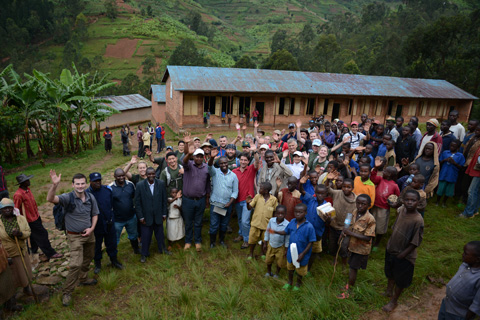
Photo: After installing solar panels that will bring light to the Kivune Primary School in Janja, Rwanda, Northland challengers celebrate with school children and Janja community members.
BUGIRI, Uganda—A look of concern crosses Northland Controls CEO Pierre Trapanese's face.
There are nine people in four cars and we've stopped at the entrance to the Bwindi Impenetrable National Park, where every driver must sign a logbook before passing through. There were nine Northland Challenge vehicles ahead of us by at least a couple of hours, but only one of those vehicles has crossed this checkpoint thus far. Where are the others?
Trapanese consults a map. He calculates: If they took this wrong turn, they'll be on a less scenic road, but they'll actually arrive at the destination—Ruhengeri, Rwanda—faster than the rest of us. On the other hand, if they took this other wrong turn, they will drive five hours out of their way.
Trapanese shrugs. “They'll figure it out,” he says.
And they do.
Several hours later, 13 muddy Toyota RAV4s are parked outside the Gorilla Hotel in Ruhengeri. All Northland Challenge participants relax in the hotel dining room and swap stories. Paul Pacitto is cracking people up with tales of hair-raising hairpin turns and George Gemmill is playing and replaying a funny iPhone video from the plane ride to Entebbe.
So, what is the Northland Challenge?
It combines elements of extreme team building and elements of “The Great Race.” It is sponsored by Northland Controls, a global systems integration company, and PSA Security owner, based in Fremont, Calif., with offices in Washington, D.C., London, Shanghai and Singapore.
The weeklong Challenge takes us across Uganda and into Rwanda. It's an odyssey that's also an exercise in how to thrive as a worker and as a business in today's global economy.
Along the way you become more comfortable when it's time to “figure it out.” The team element makes that easier, says Vivian Hodges. “The team empowers you to experiment, to try things out,” she said.
There are 27 challengers—22 men and five women ranging in age from 24 to 60. Most are Northland Controls employees, though five of us work in other roles in and around the security industry.
We're paired in two-person teams. Each team has its own 20-year-old, beat-up Toyota RAV4, and we've all chosen team names such as, U-gan-da Wrong Way, Shaka Zulu, and a Fish Called Rwanda.
Here's a sampling of events from the first 48 hours.
Cesar Bonillo and Amanda Hill had baboons jump on the top of their vehicle and refuse to jump off.
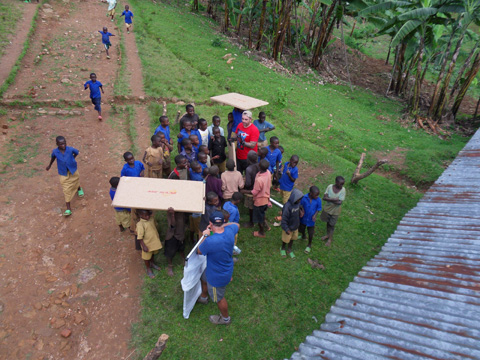
Photo: Guy Morgante and Terry Browne unpack solar panels with the help of school children
Vivian Hodges and Tim Nestor's car is surrounded by angry, stomping, ear-flapping elephants that swing their trunks inches from the car's open windows. After the elephants finally, thankfully, leave and Tim starts the car, Vivian spots a bull elephant behind them. The bull elephant charges them as they speed out of the park.
A black mamba snake raised itself two feet off the ground and hissed a not-so-friendly greeting to James Kendall and Sherwin Carr, who decide to stay in their RAV4.
During a chimp-tracking hike through the Kibale Forest National Park an adult chimp turned the tables and decided to track us. Sprinting straight at Trapanese, the chimp performs an impressive high-speed cornering move just inches from Trapanese and then swiftly brushes by Edward Wears.
We've also seen emerald green hillside tea farms, banana tree plantations, very rudimentary indoor plumbing in some locations; beautiful, smiling children and women in gorgeous, brightly colored dresses with coordinated sashes and headscarves; and we've met many kind, helpful locals.
It's not your average day in the office.
A key element of the Northland Challenge is that we only learn our destination for the day at dinner the night before. We're given a paper map with varying degrees of detail. For example, the Day 3 destination is a campsite. The address? “Unnamed road.”
Then there are “challenge points,” things like: take a photo of a hippo or a photo of yourself with a stranger at the marker for the equator. We're given a number of options for activities (i.e., do a self-guided safari; take a boat ride); some warnings (“this is not a race; don't feed the lions; if you reach this bridge you've gone too far.”) We're encouraged to explore along the way.
How do the challengers react to the unstructured structure of the Challenge? Echo Guo said she remembers advice from her mother to think about the worst-case scenario—if you can handle that, go for it. If not, it's time to regroup.
Amanda Hill called the lack of structure “freeing.” James Choi observed that when you don't have an exact route charted for you and a strict accompanying timeline, you worry less, he said.
Lacking very specific expectations, you're free to discover, they say.
Driving the roads of Uganda and Rwanda, you get a close-up view of how the locals spend their days.
Jim Conley said he was struck by “the incredibly hard work that goes on as people try to lead their lives here. …They're pushing bicycles with huge bunches of bananas up hills,” he said. Much of the terrain is steep hillsides divided into a patchwork of terraced farms. “I don't know how they walk on those hills, never mind work on them,” Conley said.
Along the roads, men, women and children tote all manner of produce, livestock, clothing and vessels on their bikes and on their heads. A few people carried bricks made from the red Ugandan soil.
Guy Morgante, my partner on Team “Help, Help Me Rwanda,” observed that in many cases, especially in the more urban areas, what the people carry appears to be their livelihood, their portable business.
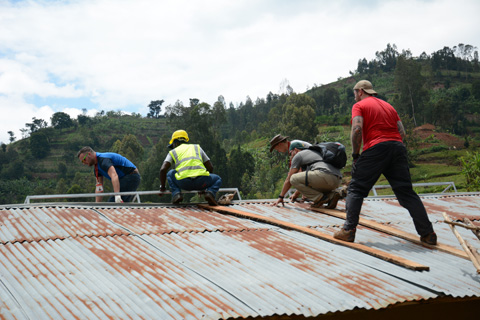
Photo: Rob Kay, Cesar Bonilla, James Kendall, Terry Browne and a Dassy technician install the solar panels
When you share the roads with cars, bikes, trucks, livestock and pedestrians, the right of way is often left to interpretation. The default seemed to fall to large trucks, although Paul Pacitto might argue that “Team KP 4 RAV” took the right of way when his partner, Kirsten Klokis, was at the wheel.
Driving in this part of the world is dusty business. The car stirs the soil up into a dense reddish-orange dust cloud that follows you as you drive.
The urban roads are lined with buildings that appear to double as homes and shops. They're mostly one-room buildings, made of concrete or creatively constructed from every imaginable found item—car parts, discarded furniture, odd-shaped boards.
But, even in the urban areas you don't have to look too far beyond the roadside buildings to see that this is a place where things grow. The palette of the landscape changes from green to gold depending on whether you're in the hills or the savannah, but it's all lush and fertile.
As Westerners driving RAV4s, we provide an amusing spectacle for the locals. Seeing one of our cars approach, children race to the side of the road. They smile, wave and shout, “how are you?” and “mazungu,” a friendly greeting that roughly translates to “lost foreigner.”
In many areas, however, the children will hold out their hands and say “give me money.”
Challenger Joseph Park said those kids “reminded me of myself 40 years ago in Korea. … It was after the Korean War and our country was destroyed.” When foreigners drove through his neighborhood, Park and his friends chased after the cars yelling, “Give me chocolate.”
Park's life changed quickly as South Korea was rebuilt. His family went from being hungry to prosperous in a matter of 10 years. Today South Korea is the twelfth-wealthiest nation in the world and Park and his childhood friends are well-educated, successful professionals. Park said he'd like to see these children benefit from education and economic development the same way he did.
However, he noted that the children we saw “all look happy. … In this country they have everything they really need. There is water, it never gets cold, there is food everywhere.”
Charles Duncan observed that traveling through Uganda and Rwanda it became clear that “life is a lottery and we won.” And yet, like Park, Duncan points out that the people we encounter seem happy. The contrast between their obvious happiness and the unhappiness of many Westerners is not lost on the challengers.
This year's trip to Uganda and Rwanda is the third Northland Challenge. In 2010 a group “raced across India in Tuk Tuks,” and in 2012 the Challenge involved 4x4s and the Caucuses Mountains.
The 2014 Challenge has a new and very important component: service.
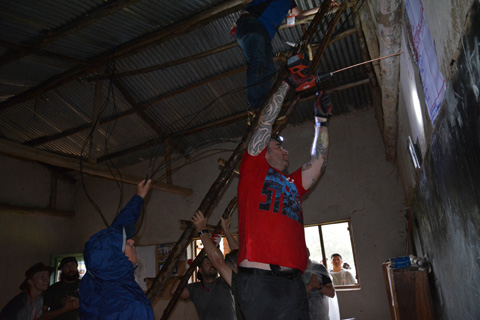
Photo: Terry Browne and others at work inside the Kivune Primary School in Janja, Rwanda
“We are challenging ourselves to go a step further, to leave behind for the people we encounter an opportunity to accelerate their economic development and to thrive as individuals and as a community,” Trapanese said.
The day of service takes place on Day 5 at the Kivune Primary School in Janja, Rwanda, and it's the hands-down highlight of The Northland Challenge. Click here for details about the day of service and how the solar project is kickstarting a self-sustaining enterprise that will bring clean energy, jobs and opportunity to this community.
We drive two hours on a heavily rutted road from our hotel in Ruhengeri to Janja. Then, we find out the school is 3-mile hike away.
Hiking the narrow, slippery trail to the school is the kind of heart-rate elevating workout some Westerners pay trainers big money for.
At one point, we must traverse a makeshift bridge. I'm looking around and all of the challengers in front and behind me seem unfazed about walking across a slippery log that's suspended several feet above a fast-moving muddy river.
Apparently I'm the only challenger who doesn't like heights. With the help and encouragement of James Choi and Guy Morgante, I don't look down, I walk across the log, I figure this out, and I feel great. At some point it occurs to me that this trek is the daily commute to school for hundreds of kids.
James Kendall and Rob Kay are the first to arrive at the school.
“Rob has the soccer balls with him and we see all of the kids dressed in their blue tops. The moment we arrive there are a hundred kids coming toward us. They're waving and they're so happy,” said Kendall.
Vivian Hodges said the day of service “was like the kind of thing you see on TV, but I never fathomed that I would have the opportunity to be part of something like this.”
Trapanese remarked that it looked like a Hollywood set. Indeed the school buildings are surrounded on all sides by steep hills that are covered in a green and red tapestry of tea farms and bamboo forests.
Terry Browne said he did not expect the trip or the day of service to “have the impact on me that it did, because I've done a lot of traveling and seen a lot of poverty.”
He and others worked “in the small [control] room. It's daylight outside, but it's still so dark in the room. Then I realized why it is so important to put lights in this school,” Browne said. “We were not going to leave without getting the lights on.”
Sebastian Ross, who sits on the Northland Controls board, is an entrepreneur and author who studies the lifecycle and management of fast growing companies. As a company grows it's essential to “get the people-part right,” he says, because “in the chaos of growth, the culture can easily get lost.”
He views the Northland Challenge as a “remarkable initiative.” Sharing fun, adventure and a week in a car, colleagues learn “about each others' lives and families. It makes working together so much easier, because you get to know each other. You're more forgiving, tolerant, patient with each other,” he said. Importantly, the experience also builds trust, which is paramount in a working relationship, Ross said.
Place this experience in a foreign country, where you might get lost, encounter wild animals, and have to figure out how to install lights in a remote village together, “you overcome fears and you learn some things about yourself,” Ross said.
As I'm speaking to Ross, challengers are bustling around the school grounds. They're using a stick ladder that was hammered together this morning to pass solar panels up to the roof. Inside the school buildings, they literally have to sit on each others' shoulders to drill holes in the walls and run cable.
“It's really powerful,” Ross says. “These guys will never forget this.”
Sherwin Carr worked with Shad McPheter to guide light switches in every room. “I'm not a technician, I'm a software engineer,” Carr said, laughing. Carr and others enjoyed taking time out from the installation to teach the kids how to throw an American football.
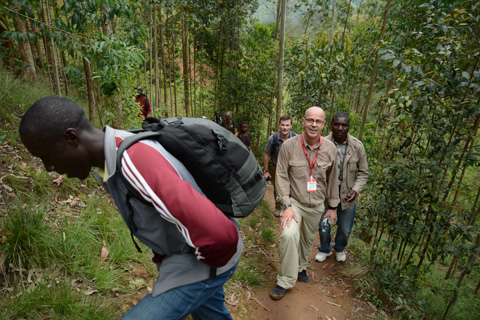
Photo: Paul Pacitto on the hike to the school
Terry Browne said that the “U.K. and U.S. guys bonded really well. It was really good from a company perspective to get people from different regions together to have fun, [grapple with] challenges, and integrate with the community.”
Edward Wears, Rob Kay, Josh Akre and others echoed Browne's sentiments about the singularity of working, for the first time, side by side with his Northland colleagues from other countries, and figuring out how to work with the Dassy [local installation company] technicians as well.
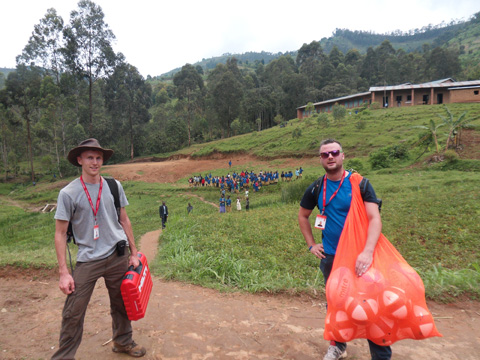
Photo: James Kendall and Rob Kay are the first to arrive at the school.
Shad McPheter said working with his colleagues in a volunteer setting. “You see a different side of people outside of the workplace.”
Browne said that when the team finally succeeded in getting the lights to come on, “I was choked up. I have never been so pleased to see a light come on in my life.”
Eric van Muijen added: “What gave me goose bumps was the cheers when we flipped the switch and the lights came on. Not just our cheers, but the cheers of the kids and the parents that were there. That was huge.”
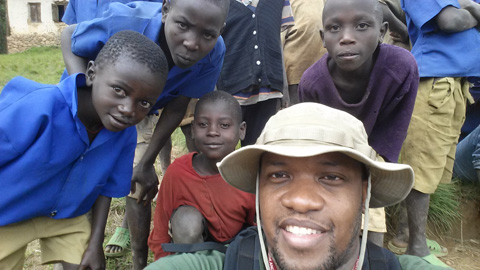
Photo: Sherwin Carr takes a selfie with some of the school kids.
Cesar Bonilla said he “loved how happy the kids were and the adults kept saying thank you.”
Tim Nestor has traveled the world and spent a lot of time in Africa. What stands out for him from the experience is “the impact this [solar] project is likely to have. It's a very poor community, but instead of a handout, they get an operational business that's likely to impact everyone's lives in probably more ways than anyone can figure out today.”
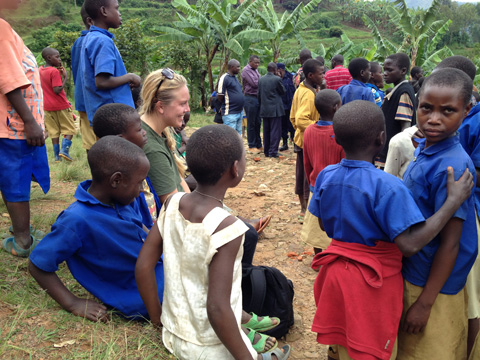
Photo: Amanda Hill plays with the school kids at the Kivune Primary School.
Amanda Hill works for Firelight Foundation. “Personally, this experience reminds me of why I do what I do for work.” Seeing the relationship between Northland, Inkoramutima [a Rwanda community organization] and Dassy [the local installers] come together was rewarding, she said. “To see it happen is so different from writing or reading about it. It gives me new energy and so many stories to tell my colleagues.” Click here to read a blog post from Amanda.
Kirsten Klokis said the Challenge helped break down some negative stereotypes she'd heard about Africa. She and others enjoyed discovering what Vivian Hodges described as a “warm, loving culture that has a wild edge to it.”
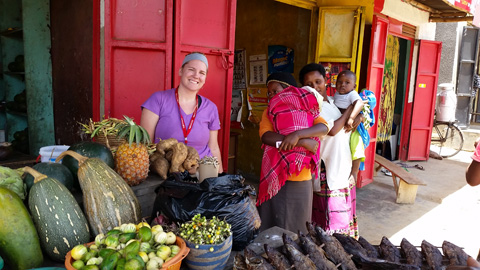
Photo: Kirsten Klokis at a roadside vegetable and fish market.
Drew Greenslate said he felt “a sense of safety that you don't always feel in the third world.” Eric van Muijen added that he “feels safer here than I do in a big city.”
Andre Fiset, who runs a Montreal integration firm that works with Northland, summed up the Northland Challenge this way: “It is so much fun.”
“Have fun” is one of Northland's stated core values, along with “Take on challenges, be honorable, [support] our people, and do whatever it takes.”
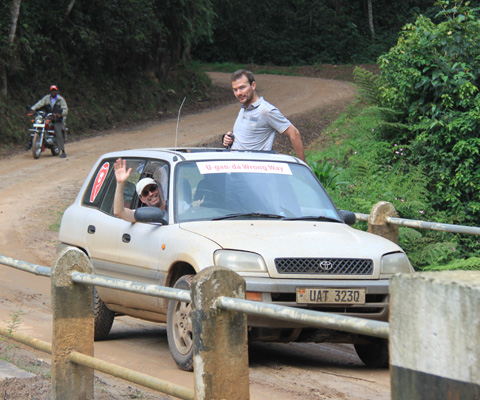
Photo: 'Have fun' is a stated value for Northland Controls. Jim Conley is at the wheel of Team "U-gan-da Wrong Way's" RAV4, while his partner, Edward Wears, navigates and photographs the ride from the vantage point of the sun roof opening.
The Challenge, Trapanese says, is about “breaking down stereotypes, overcoming our fears of the unknown, and getting out of our shells to work with locals to find our way from one end of their country to the other without the use of technology.”
Talking to Trapanese, you learn that a challenge-type experience is “normal” to him. He lived in different parts of the world growing up including Algeria. He tells the story of how a National Geographic article inspired his parents to pile Pierre, his brother, sister and their black lab into a white VW bus and take off in search of the Blue Men of the Sahara. Challenges ensued, including getting stranded in a sand dune that had blown over and erased all traces of the road, but they figured it out.
"That was our family vacation," he said, laughing.
And the prototype for the Northland Challenge?
Comments